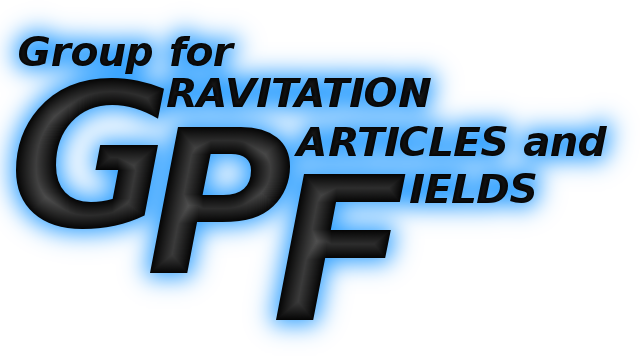


Seminars for the year:
2025
2024
2023
2022
2021
2020
2019
2018
2017
2016
2015
2014
2013
2012
2011
2010
2009
2008
2007
Follow our seminars online via: GPF BigBlueButton server
Time: 20. July 2012, 11:00h
Place: Institute of Physics, room 10
Speaker: Blagoje Oblak
Title: Symmetries of 3d asymptotically flat spacetimes
Abstract:
I will review basic results on asymptotic symmetries of three-dimensional asymptotically flat space-times. Beginning with asymptotic Killing vectors, I will continue with the definition of the BMS3 group and the bms3 algebra. After that, I shall discuss the most general central extension of bms3 and I will show that surface charges of asymptotically flat space-times satisfy a special case of this centrally extended algebra. Finally, I will say a few words on highest-weight representations of bms3.
Time: 6. July 2012, 11:00h
Place: Institute of Physics, room 10
Speaker: Marija Dimitrijevic
Title: Geometric generalization of the Seiberg-Witten map and its applications (part two)
Abstract:
Seiberg-Witten (SW) map is a map that relates a noncommutative gauge theory with the corresponding commutative gauge theory. In this talk we discuss a geometric generalization of the SW map and its application to the NC gravity theories. Our motivation is twofold: on one hand we would like to generalize the SW map for the constant noncommutativity to some examples of non-constant noncommutativity. On the other hand, using index-free notation (writing an action in terms of differential forms) simplifies calculations. As an example of this formalism, we show how a second order correction to the NC SO(2,3) gravity action can be written in an elegant way.
Time: 27. June 2012, 11:00h
Place: Institute of Physics, room 10
Speaker: Marija Dimitrijevic
Title: Geometric generalization of the Seiberg-Witten map and its applications (part one)
Abstract:
Seiberg-Witten (SW) map is a map that relates a noncommutative gauge theory with the corresponding commutative gauge theory. In this talk we discuss a geometric generalization of the SW map and its application to the NC gravity theories. Our motivation is twofold: on one hand we would like to generalize the SW map for the constant noncommutativity to some examples of non-constant noncommutativity. On the other hand, using index-free notation (writing an action in terms of differential forms) simplifies calculations. As an example of this formalism, we show how a second order correction to the NC SO(2,3) gravity action can be written in an elegant way.
Time: 15. June 2012, 11:00h
Place: Institute of Physics, room 300
Speaker: Voja Radovanovic
Title: Noncommutative gravity on Moyal plane (part two)
Abstract:
We study deformation of gravity on canonical noncommutative spacetime. The starting point is the local $SO(2,3)$ symmetry on the four dimensional Minkowski space-time. This symmetry is spontaneously broken down to the local Lorentz symmetry. Then we deform $SO(1,3)$ symmetry. The construction is done perturbatively as an expansion in the NC parameter, using the SW map. As expected, the first order correction vanishes and the second order correction is written in covariant form.
Time: 8. June 2012, 11:00h
Place: Institute of Physics, room 300
Speaker: Voja Radovanovic
Title: Noncommutative gravity on Moyal plane (part one)
Abstract:
We study deformation of gravity on canonical noncommutative spacetime. The starting point is the local $SO(2,3)$ symmetry on the four dimensional Minkowski space-time. This symmetry is spontaneously broken down to the local Lorentz symmetry. Then we deform $SO(1,3)$ symmetry. The construction is done perturbatively as an expansion in the NC parameter, using the SW map. As expected, the first order correction vanishes and the second order correction is written in covariant form.
Time: 28. May 2012, 11:00h
Place: Institute of Physics, room 300
Speaker: Nikola Paunkovic
Title: Quantum contract signing
Abstract:
We present a fair and optimistic quantum-contract-signing protocol between two clients that requires no communication with the third trusted party during the exchange phase. We discuss its fairness and show that it is possible to design such a protocol for which the probability of a dishonest client to cheat becomes negligible and scales as N−1/2, where N is the number of messages exchanged between the clients. Our protocol is not based on the exchange of signed messages: Its fairness is based on the laws of quantum mechanics. Thus, it is abuse free, and the clients do not have to generate new keys for each message during the exchange phase. We discuss a real-life scenario when measurement errors and qubit-state corruption due to noisy channels and imperfect quantum memories occur and argue that for a real, good-enough measurement apparatus, transmission channels, and quantum memories, our protocol would still be fair. Apart from stable quantum memories, the other segments of our protocol could be implemented by today's technology, as they require in essence the same type of apparatus as the one needed for the Bennett-Brassard 1984 (BB84) cryptographic protocol. Finally, we briefly discuss two alternative versions of the protocol, one that uses only two states [based on the Bennett 1992 (B92) protocol] and the other that uses entangled pairs, and show that it is possible to generalize our protocol to an arbitrary number of clients.
Seminars for the year:
2025
2024
2023
2022
2021
2020
2019
2018
2017
2016
2015
2014
2013
2012
2011
2010
2009
2008
2007
Follow our seminars online via: GPF BigBlueButton server